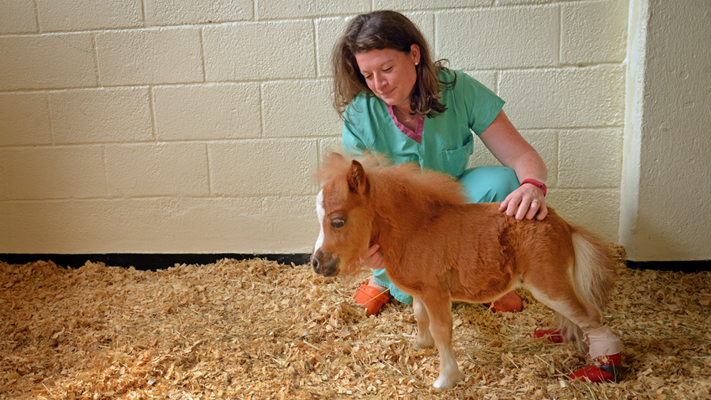Saving Tinkerbell

Tinkerbell is a two-month-old American Miniature Horse foal with a problem – well, make that two problems. Her hind limbs don’t support her properly due to a congenital defect. That’s because Tinkerbell also has dwarfism. When she’s full grown she’ll still only be about half the size of a normal miniature horse. Unfortunately, the dwarfism doesn’t just mean that she will be tiny; it can have a host of other effects. In Tinkerbell’s case those effects include laxity, the cause of her hind limb problems.
In a normal horse, ligaments and tendons keep the fetlock – a joint above the hoof which functions like a human ankle – supported and working smoothly. When those tendons and ligaments are loose, or lax, the joint can rotate inward or outward, and the horse may end up walking on the joint instead of the hoof. Picture a human walking around on his or her ankle bones, and you can see how painful and damaging this condition is.
“A little bit of this laxness is actually fairly common in foals, and it will usually resolve over time as the horse walks and runs,” says Ben Shrauner, chief large animal resident at NC State’s College of Veterinary Medicine (CVM). “But in Tinkerbell’s case, the tendons and ligaments were much too loose to ever correct themselves, even with external support. Over time, if she continued to walk on the joint it would dislocate. It would also cause the leg bones to deform and the skin over the joint would erode, leading to severe infection.”
Essentially, Tinkerbell’s problem, if untreated, would be fatal. Tinkerbell and her mother are rescue animals who had been taken in by the Dunbar and Newsome families shortly after Tinkerbell’s birth. The Dunbars contacted Denis Marcellin-Little, an orthopedist at the CVM, to see what could be done to help the mini foal. He recommended a procedure that is usually performed on racehorses who suffer fractures: arthrodeses of both fetlocks.
Arthrodesis involves installing a metal plate into the bone along the front of the lower leg, completely immobilizing the fetlock joint. Over time, the fetlock joint fuses and the limb is stable. The horse loses that joint’s flexibility but can still stand and walk normally. Arthrodesis is usually done on racehorses who have broken a bone in the back of the fetlock. The broken bone causes the ligaments to pull apart, resulting in a weakened fetlock and a condition similar to Tinkerbell’s.
“The procedure itself isn’t uncommon,” Shrauner says. “But using it specifically to treat laxity is uncommon – we believe Tinkerbell is only the second such case.”
Shrauner, Marcellin-Little and equine surgical specialist Rich Redding performed the three-hour surgery on Tinkerbell, installing locking compression plates on both hind limbs. The plates use a series of different types of screws to attach to the bone and immobilize the joint. Due to Tinkerbell’s diminutive size, the surgeons used plates designed for a small dog. Once Tinkerbell woke up, she was able to walk normally back to her own stall.
After a short stay at the hospital, Tinkerbell went home and on to “stall rest” for the next 90 days. Shrauner will X-ray her legs once a month to be sure that everything is healing properly. If all goes well, Tinkerbell’s prognosis for a long and healthy life (the oldest dwarf mini on record lived to be 50) looks very good.
- Categories:


